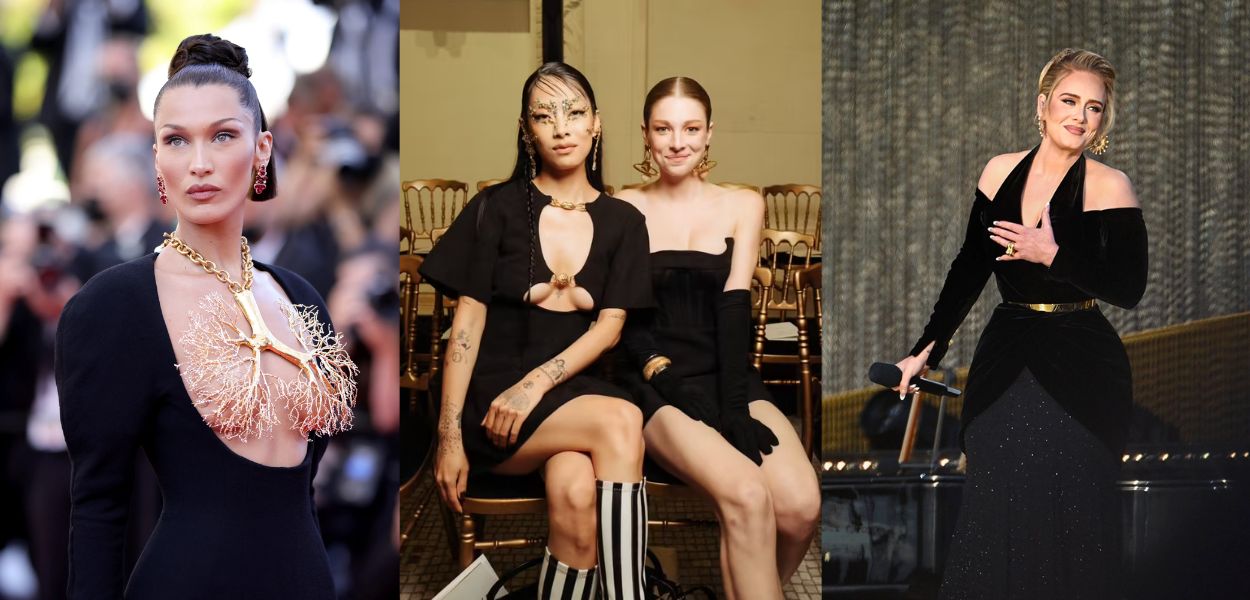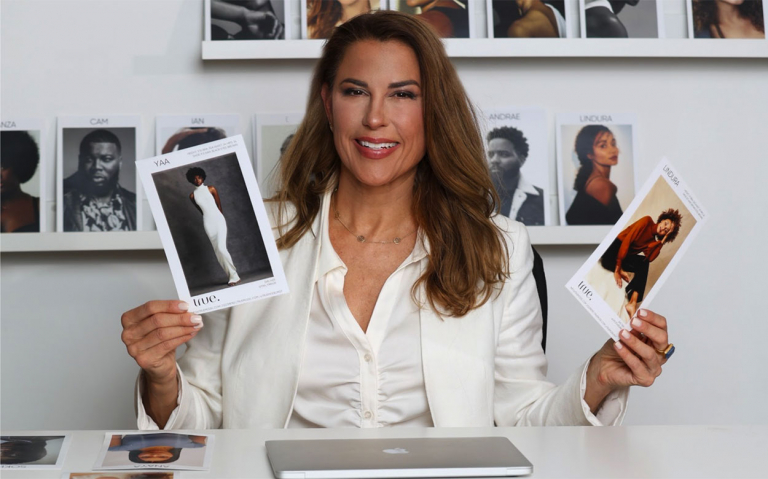Featured Image credits: Andreas Rentz (Getty Images), Schiaparelli Official Website & Gareth Cattermole (Getty Images).
After Donald Trump’s reign, Lady Gaga sang the national anthem for the Biden inauguration dressed in symbols. The singer wore an oversized golden dove brooch over a navy blue jacket and a billowing red skirt. Her message was clear: peace was coming to the United States of America. Such a powerful sartorial statement could have only been the product of a brand with a powerful social mission: Schiaparelli.
Since then, it seems as though Schiaparelli is everywhere. In the art for Lizzo’s recent hit, “Rumors.” Once again on Lady Gaga, this time for her latest Vogue cover. On the Cannes red carpet, hanging by Bella Hadid’s neck. On Julia Fox and Ye’s couple outfits. Certainly, everywhere.
But where did the brand come from? And why is it making headlines today? Perhaps shockingly, the brand is now almost a hundred years old. And its penchant for the fantastic, the strangely beautiful, is by no means a new phenomenon. So, if you want to know more about Schiaparelli’s history, keep reading!
A Woman and a Brand Against the Norms
An Independent Individual
Elsa Schiaparelli was born in 1890, in Rome, under the roof of an Aristocratic family. She was by all means of a whimsical, dramatic character. As a child, she attempted to plant flowers on her face, to make herself more beautiful. When she was 21 years old, she published a poetry book, the contents of which shocked her conservative family.
Rebellious by nature, Elsa moved to London in 1913, all to avoid the advances of a Russian suitor. Still, she married a lecturer the following year, after knowing him for only a few days. In 1919, they moved to New York City.
Sadly, Elsa and her husband separated in 1920, after she gave birth to her daughter. She became a financially independent woman, which wasn’t precisely common at the time. So, in 1922, Elsa moved to Paris.
It was then, in 1924, that she met Paul Poiret, one of the very first European couturiers. At the time, Elsa was dabbling in writing and sculpting. Noticing her natural sartorial talent, Poiret encouraged her to formally pursue dressmaking. And thus Elsa Schiaparelli began selling her pieces, which, much like her, diverged considerably from what was common at the time. Through her clothes, Schiaparelli aimed to push against the norm.
Clothes to Reflect the Person
After some years of freelance work, Elsa finally opened an atelier in 1927, with her first collection, Pour le Sport. This was a turning point in the designer’s career. Her choice to focus on day and sportswear reflected a mission to support women in their after-war liberation.
Remarkably, it was her trompe-l’oeil sweater that allowed the brand to amass a significant following. The garment created the illusion of a butterfly bow in the front, though said bow was just part of the knit. The designer wore the sweater to a function, where it caught the eye of hundreds of wealthy socialites. Its impact was such that it was featured in Vogue’s 1927 December issue. It was clear: Elsa knew what women wanted and how to innovate it.
Hence, through her subsequent designs, she aimed to leave behind the conventions and constraints of her time. In fact, she was similar to her rival, Coco Chanel, in her mission to liberate women through clothes. Nevertheless, while Chanel changed the game by creating a new silhouette, Schiaparelli’s intervention was more abstract.
Surely, her designs remained femininely shaped, yet the concepts behind them completely diverged from the norm. The brand had a quirky, imaginative aesthetic. Its “mad cap”, for instance, pointed at the end, hugging around the head, was staggeringly fashionable, yet extremely particular.
Schiaparelli, Art and the Artists
Schiaparelli’s bizarre look was, in a lot of its instances, tied to surrealism. Certainly, Elsa frequented artistic circles, where she became acquainted with the obsessions and fascinations of innovators. And so fell in love with the most prominent movement of the inter-war period: surrealism.
Surrealism’s main aim was to shock bourgeois society. As Buñuel, the great surrealist filmmaker once put it, surrealism intended to “explode the social order.” Of course, this was very in line with Elsai’s vision, as she looked to push the boundaries of fashion.
Thus, it’s really no wonder she continuously collaborated with surrealist artists. She and Meret Oppenheim worked on a metal fur bracelet in 1936. In 1937, along with Jean Cocteau, she created an embroidered trompe-l’oeil coat. The garment featured faces that doubled as a vase, as well as pink roses.
Most remarkable among her collaborations is her long-term partnership with Salvador Dalí. Together they created the “tear dress”, “skeleton dress”, and “shoe hat”, to name a few. These creations all intended to shock bourgeois sensibilities, rebell from the horrors of the wars.
All and all, Elsa Schiaparelli pioneered the melding of art and fashion. Unlike others, the designer did not intend to use fashion as a reflection of art. Rather, it was all a successful attempt to create fashion out of art. It seemed that clothes were just another kind of canvas for her.
The End and the Resurgence
An Abrupt Finish
During the Second World War, Schiaparelli was forced to close her Paris atelier and move to New York. Upon her return to the French capital, the brand failed to regain the popularity it had previously enjoyed. Taste had shifted, and the introduction of Dior’s new look obscured the Maison. It was finally forced to shut down in 1954.
Luckily, this did not mean an end for the Schiaparelli brand. For Tod’s owner, Della Valle, purchased the rights to the label in 2007. Fast forward to 2013, Marco Zanini was appointed creative director of Schiaparelli. Nonetheless, the brand didn’t really take off until recently, after Daniel Roseberry was put at its head. This represented a complete resurrection for the Maison.
The Resurgence of Schiaparelli
We find ourselves in terribly uncertain times, where it all feels directionless and strange. As fashion reflects its context, it is really no wonder bizzarro fashion is on the rise.
Under this light, the triumph of Roseberry’s Schiaparelli seems inevitable. The designer heavily leans on the maison’s surrealist heritage to, like Elsa, give women what they want. For him, haute couture is too focused on traditional femininity, which many women no longer identify with. So he proposes an alternative; couture for the modern woman.
The results are pieces which almost seem fantastical. Corsets with toned abs sculpted onto them. Jewelry which mimics the body part it decorates. Claw-like gloves. And everything in between! The success of this strange fashion is unmeasurable and Schiaparelli is not going anywhere. We, for one, cannot wait to see what’s next.
Like this article? Check out the story of the iconic Coco Chanel.






